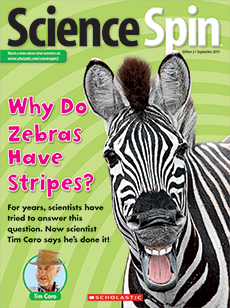May-June 2022
Baby Shark in a Tree
Academic Standards
Reading Objective:
Students will recognize that a mangrove swamp habitat nurtures baby sharks.
Reading Level:
Lexile: 460L; GRL: L
Next Generation Science Standards:
2-LS4--1: The diversity of life in a habitat
2-ESS2: Shapes and kinds of bodies of water and land
Vocabulary:
mangrove, roots, swamp
Use these questions to check students’ understanding and stimulate discussion:
1. What kind of trees do baby lemon sharks live in?
(mangrove trees)
2. Where do mangrove trees grow?
(in water)
3. What is a swamp?
(a forest covered with water)
4. Name some ways that mangrove trees give baby sharks what they need. (The trees’ roots provide safety as well as a place to find friends and food, like fish and crabs.)
Go online to print or project the Reading Checkpoint.
- Baby lemon sharks are only 2 feet long. They can grow to be 10 feet long.
- A group of sharks is called a shiver.
- Mangrove trees are being cut down to build hotels by the sea. People are working to protect mangroves, which will help baby sharks.
Materials: 12˝ rulers, pencils, copies of the skill sheet
Overview: Students measure classroom objects to discover which are longer and shorter than a 2-foot baby lemon shark.
Directions:
- Gather students. Remind them that baby lemon sharks need to hide from big sharks because they’re small—just 2 feet long.
- Tell students that scientists measure objects, and sort them according to size. Show kids a 12˝ ruler. Could they measure the length of a baby shark with this? Ask someone to demonstrate how it could be done.
- Hand out rulers, pencils and skill sheets. It’s time to measure classroom objects and record! What can students find that’s longer than a baby shark? What is shorter? What is about the same length? (This is more a bout sorting than precise measurement.)
- Record findings on the skill sheets.
- If there’s time, students can share results.
